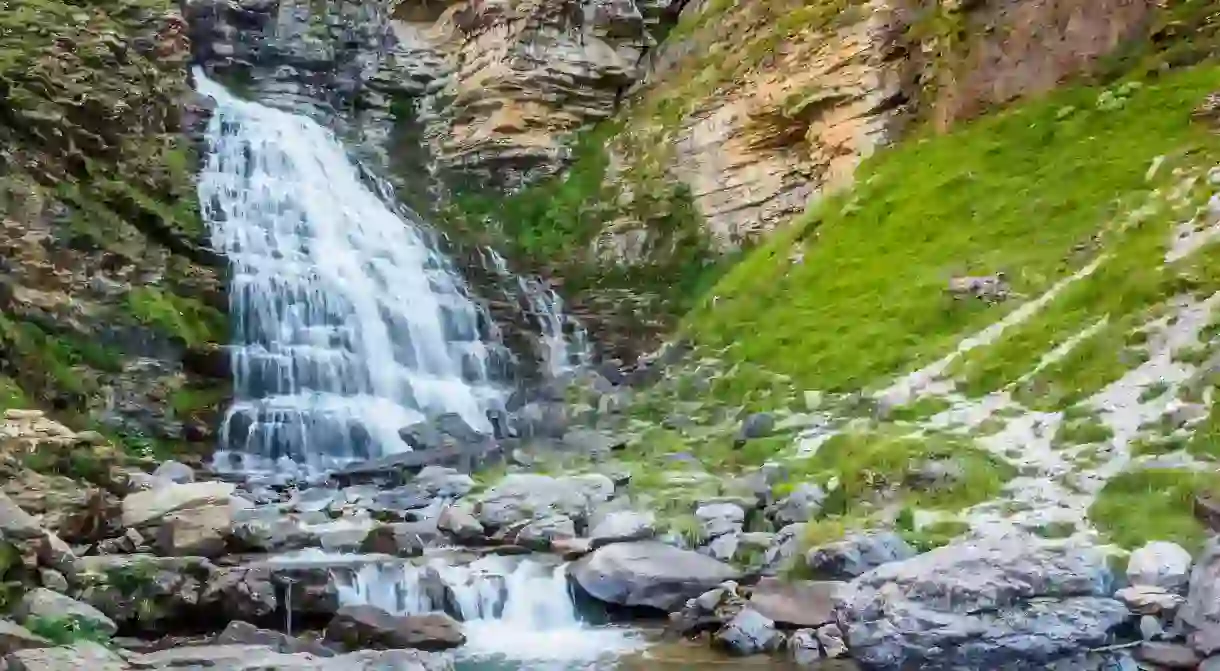An Adventure Traveller's Guide to Aragon, Spain

Located in northern Spain, Aragon is a landlocked province which stretches to the Pyrenees mountains and the border with France. Aragon’s drastic terrain makes it ideal for many types of outdoor activities such as hiking, abseiling, mountain biking and even skiing. Here’s our adventure traveller’s guide to making the most of Aragon.
Hiking
Hiking is one of the easiest outdoor activities to enjoy in Aragon: pretty much everywhere you go you’ll find lush natural landscapes and signed routes. One of the most popular places to hike is the Ordesa y Monte Perdido National Park, a large natural park located on the border with France. This is where you’ll find some of the most challenging hikes in Aragon – peaks here reach above 3,000m (9,843 feet) – but also some of the most scenic: the Circo de Soaso is a picture-perfect natural waterfall in the Ordesa Valley.
Yet other parks such as the Moncayo Massif in central Aragon are equally worth exploring. The small town of San Martín de Moncayo is the starting point for many of the trails, which range from easy to difficult. There’s a tourist information centre in the town which will be able to advise on the best routes on the day for your level of fitness and what you want to see.

Canyoneering
When it comes to canyoneering in Aragon, one name stands above all the rest: the Sierra de Guara. This mountain massif is located in the region of Huesca and, thanks to its many gorges, has become a hotspot for outdoor activities in recent years. The variety and concentration of the gorges in the Sierra de Guara is outstanding and the area is considered on of the best places for canyoneering in Spain.
Those who have never tried canyoneering before or want an easier experience will enjoy the scenic Rio Verde gorge or the lower Peonera gorge, while those who want more of a challenge should seek out the Barranco Mascun gorge or the Fornocal gorge, which offers some exceptional panoramic vistas. In any case, there are a number of local companies offering expert guidance at reasonable prices to make sure you stay safe and have fun.

Winter sports
Aragon is home to some of the best ski resorts in Spain, such as Formigal-Panticosa and Candanchú – which also happens to be the country’s oldest. Skiing in Spain is generally less expensive than in France or Switzerland, making a winter sports holiday all the more enticing. And because access to the mountains is often relatively easy – you can be on the slopes in less than three hours from Valencia or Zaragoza – you can even make skiing a day trip.
Many of the biggest resorts are located to the north of Aragon, in the Pyrenees mountains: Formigal-Panticosa, Astún, Cerler. The latter was voted best ski resort in Spain back in 2014 and offers the biggest descent in the Aragonese Pyrenees: from a peak of 2,630m (8,629 feet) to the base at 1,500m ((4,921 feet). Yet there’s skiing to be found further south as well, such as the Valdelinares resort located just 150km (93 miles) north of Valencia. The resort is well-equipped with snow-machines so you can expect good coverage on the pistes throughout the season.

White water rafting
With so many rivers gushing straight from the Pyrenees mountains, it’s no wonder Aragon is a top destination for white water rafting in Spain. While you may not quite get the thrills of the Colorado River, the rafting in Aragon is undoubtedly good fun and a great way to get to know the valleys.
The town of Murillo de Gállego is where you’ll find the greatest concentration of rafting companies, as well as canoeing and kayaking companies too. In many cases rafting can be a nice family activity, with kids as young as eight allowed to participate so long as they can swim.

Abseiling and rock climbing
Of course, with such a concentration of mountains and gorges, Aragon is also a popular destination for rock climbing and abseiling. As with the skiing, many of the top climbing spots are located in the Pyrenees mountains, but there are some spots located further south, such as those located around the town of Alcañiz and a handful to the south and west of Zaragoza.
Undoubtedly the most famous spot for climbing are the Riglos de Mallos which are also where some of the most technical climbs are found (ranging up a grade 7c). These conglomerate rock formations are incredible to see and even more incredible to climb, with some 200 different routes available starting from a grade 4.














